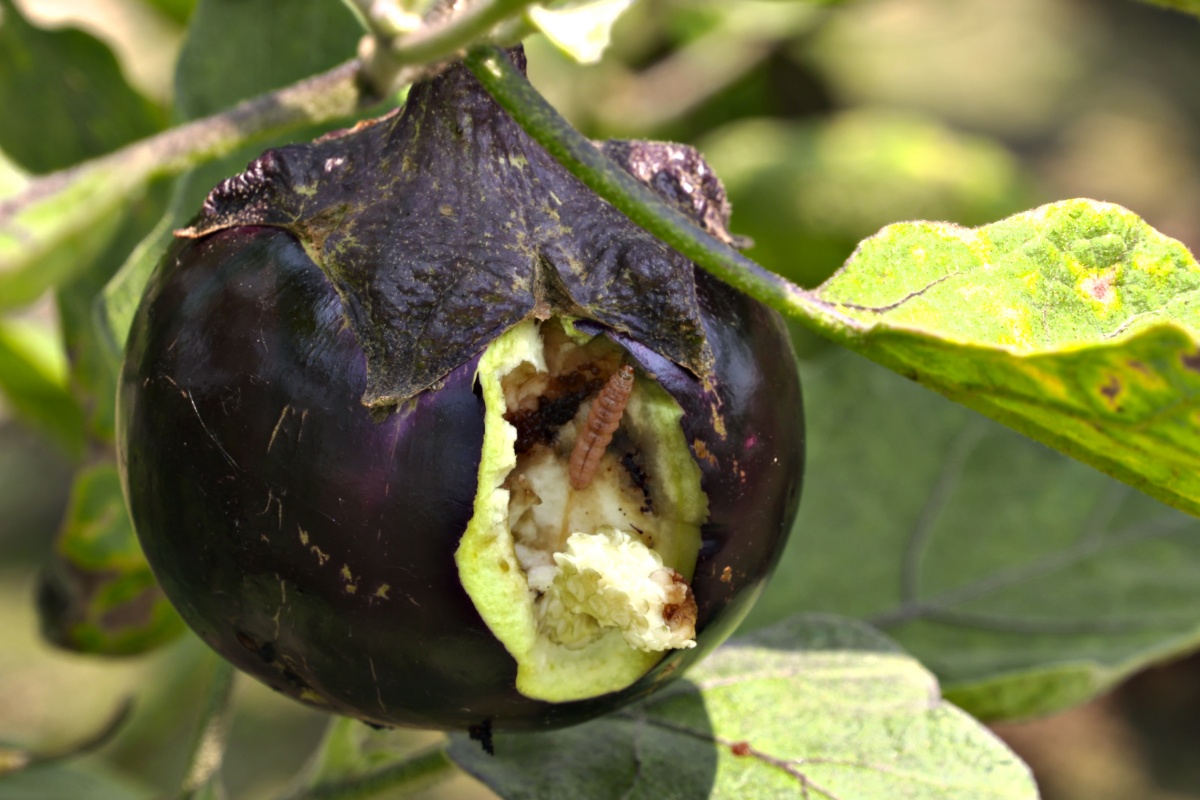I have two bits of genetic engineering news.
Eggplants in Bangladesh
I always marvel at their beauty,

Bt eggplant is the first genetically engineered food crop to be successfully introduced in South Asia. The crop is helping some of the world’s poorest farmers feed their families and communities while reducing the use of pesticides. Photo by Cornell Alliance for Science.
A July 17, 2018 news item on phys.org describes a genetic engineering application,
Ansar Ali earned just 11,000 taka – about $130 U.S. dollars – from eggplant he grew last year in Bangladesh. This year, after planting Bt eggplant, he brought home more than double that amount, 27,000 taka. It’s a life-changing improvement for a subsistence farmer like Ali.
Bt eggplant, or brinjal as it’s known in Bangladesh, is the first genetically engineered food crop to be successfully introduced in South Asia. Bt brinjal is helping some of the world’s poorest farmers to feed their families and communities, improve profits and dramatically reduce pesticide use. That’s according to Tony Shelton, Cornell professor of entomology and director of the Bt brinjal project funded by the United States Agency for International Development (USAID). Shelton and Jahangir Hossain, the country coordinator for the project in Bangladesh, lead the Cornell initiative to get these seeds into the hands of the small-scale, resource-poor farmers who grow a crop consumed daily by millions of Bangladeshis.
A July 11, 2018 Cornell University news release by Krisy Gashler, which originated the news item, expands on the theme (Note: Links have been removed),
Bt brinjal was first developed by the Indian seed company Mahyco in the early 2000s. Scientists inserted a gene from the bacterium Bacillus thuringiensis (thus the name, Bt) into nine brinjal varieties. The plants were engineered to resist the fruit and shoot borer, a devastating insect whose larvae bore into the stem and fruit of an eggplant. The insects cause up to 80 percent crop loss.
The Bt protein produced by the engineered eggplant causes the fruit and shoot borer larva to stop feeding, but is safe for humans consuming the eggplant, as proven through years of biosafety trials. In fact, Bt is commonly used by organic farmers to control caterpillars but has to be sprayed frequently to be effective. The Bt eggplant produces essentially the same protein as in the spray. More than 80 percent of field corn and cotton grown in the U.S. contains a Bt gene for insect control.
“Farmers growing Bt brinjal in Bangladesh are seeing three times the production of other brinjal varieties, at half the production cost, and are getting better prices at the market,” Hossain said.
A recent survey found 50 percent of farmers in Bangladesh said that they experienced illness due to the intense spraying of insecticides. Most farmers work in bare feet and without eye protection, leading to pesticide exposure that causes skin and eye irritation, and vomiting.
“It’s terrible for these farmers’ health and the health of the environment to spray so much,” said Shelton, who found that pesticide use on Bt eggplant was reduced as much as 92 percent in commercial Bt brinjal plantings. “Bt brinjal is a solution that’s really making a difference in people’s lives.”
Alhaz Uddin, a farmer in the Tangail district, made 6,000 taka growing traditional brinjal, but had to spend 4,000 taka on pesticides to combat fruit and shoot borer.
“I sprayed pesticides several times in a week,” he said. “I got sick many times during the spray.”
Mahyco initially wanted to introduce Bt brinjal in India and underwent years of successful safety testing. But in 2010, due to pressure from anti-biotechnology groups, the Indian minister of the environment placed a moratorium on the seeds. It is still in effect today, leaving brinjal farmers there without the effective and safe method of control available to their neighbors in Bangladesh.
Even before the Indian moratorium, Cornell scientists hosted delegations from Bangladesh that wanted to learn about Bt brinjal and the Agricultural Biotechnology Support Project II (ABSP II), a consortium of public and private institutions in Asia and Africa intended to help with the commercial development, regulatory approval and dissemination of bio-engineered crops, including Bt brinjal.
Cornell worked with USAID, Mahyco and the Bangladesh Agricultural Research Institute to secure regulatory approval, and in 2014 the Bangladeshi government distributed a small number of Bt brinjal plants to 20 farmers in four districts. The next year 108 farmers grew Bt brinjal, and the following year the number of farmers more than doubled to 250. In 2017 the number increased to 6,512 and in 2018 to 27,012. The numbers are likely even higher, according to Shelton, as there are no constraints against farmers saving seeds and replanting.
“Farmers who plant Bt brinjal are required to plant a small perimeter of traditional brinjal around the Bt variety; research has shown that the insects will infest plants in the buffer area, and this will slow their evolutionary development of resistance to the Bt plants,” Shelton said.
In a March 2017 workshop, Bangladeshi Agriculture Minister Begum Matia Chowdhury called Bt brinjal “a success story of local and foreign collaboration.”
“We will be guided by the science-based information, not by the nonscientific whispering of a section of people,” Chowdhury said. “As human beings, it is our moral obligation that all people in our country should get food and not go to bed on an empty stomach. Biotechnology can play an important role in this effect.”
Here’s what an infested eggplant looks like,

Non-Bt eggplant infested with fruit and shoot borer. Photo by Cornell Alliance for Science
It looks more like a fig than an eggplant.
This is part of a more comprehensive project as revealed in a March 29, 2016 Cornell University news release issued on the occasion of a $4.8M, three-year grant from the U.S. Agency for International Development (USAID),
… The award supports USAID’s work under Feed the Future, the U.S. government’s global initiative to fight hunger and improve food security using agricultural science and technology.
In the Feed the Future South Asia Eggplant Improvement Partnership, Cornell will protect eggplant farmers from yield losses and improve their livelihoods in partnership with the Bangladesh Agricultural Research Institute (BARI) and the University of the Philippines at Los Baños. Eggplant, or brinjal, is a staple crop that is an important source of income and nutrition for farmers and consumers in South Asia.
…
Over the past decade, Cornell has led the Agricultural Biotechnology Support Project II (ABSPII), also funded by USAID, that prompted a consortium of institutions in Asia and Africa to use the tools of modern biotechnology, particularly genetic engineering, to improve crops to address major production constraints for which conventional plant breeding tools have not been effective.
…
In October 2013, Bangladesh became the first country in South Asia to approve commercial cultivation of a genetically engineered food crop. In February 2014, Matia Chowdhury, the Bangladesh minister of agriculture, released four varieties of Bt brinjal to 20 farmers. With the establishment of the 20 Bt brinjal demonstration plots in 2014 and 104 more in 2015, BARI reported a noticeable decrease in fruit and shoot borer infestation, increased yields, decreased use of pesticide and improved income for farmers.
…
The Feed the Future South Asia Eggplant Improvement Partnership addresses and integrates all elements of the commercialization process — including technology development, regulation, marketing, seed distribution, and product stewardship. It also provides strong platforms for policy development, capacity building, gender equality, outreach and communication.
Moving on from practical applications …
Canada’s synthetic biology training centre
It seems Concordia University (Montréa) is a major Canadian centre for all things ‘synthetic biological’. (from the History and Vision webpage on Concordia University’s Centre for Applied Synthetic Biology webspace),
History and vision
Emerging in 2012 from a collaboration between the Biology and Electrical and Computer Engineering Departments, the Centre received University-wide status in 2016 growing its membership to include Biochemistry, Journalism, Communication Studies, Mechanical, Industrial and Chemical Engineering.
Timeline
You can see the timeline does not yet include 2018 development(s). Also it started as “a collaboration between the Biology and Electrical and Computer Engineering Departments?” This suggests a vastly different approach to genetic engineering that that employed in the “eggplant” research. From a July 16, 2018 posting on the Genome Alberta blog,
The Natural Sciences and Engineering Research Council of Canada (NSERC) has committed $1.65 million dollars over six years to establish a research and training program at Concordia’s Centre for Applied Synthetic Biology.
The funds were awarded after Malcolm Whiteway (…), professor of biology and the Canada Research Chair in Microbial Genomics, and the grant application team submitted a proposal to NSERC’s Collaborative Research and Training Experience (CREATE) program.
The Synthetic Biology Applications CREATE program — or SynBioApps — will help students acquire and develop important professional skills that complement their academic education and improve their job-readiness.
‘Concordia is a natural fit’
“As the Canadian leader in synthetic biology and as the home of the country’s only genome foundry, Concordia is a natural fit for a training program in this growing area of research,” says Christophe Guy, vice-president of Research and Graduate Studies.
“In offering a program like SynBioApps, we are providing our students with both a fundamental education in science and the business skills they’ll need to transition into their professional careers.”
The program’s aims are twofold: First, it will teach students how to design and construct cells and proteins for the development of new products related to human health, green technologies, and fundamental biological investigations. Second, it will provide cross-disciplinary training and internship opportunities through the university’s District 3 Innovation Center.
SynBioApps will be open to students from biology, biochemistry, engineering, computing, and mathematics.
“The ability to apply engineering approaches to biological systems promises to revolutionize both biology and industry,” says Whiteway, who is also a member of the Centre for Applied Synthetic Biology.
“The SynBioApps program at Concordia will provide a training program to develop the students who will both investigate the biology and build these industries.”
…
You can find out more about Concordia’s Centre for Applied Synthetic Biology here (there are jobs listed on their home page) and you can find information about the Synthetic Biology Applications (SynBioApps) training programme here.
